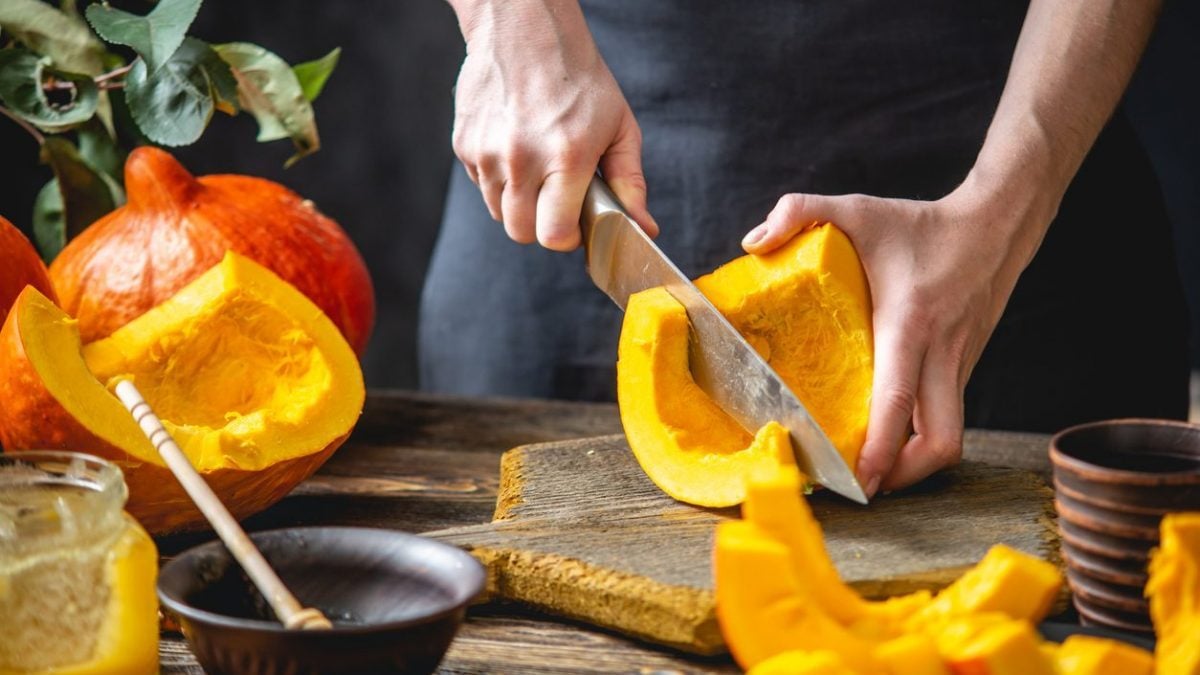
It's the superstar of fruit and vegetable stalls and our fall menus, always ready to add flavor, color, and extraordinary textures to creams, soups, side dishes, and even desserts: we're talking, of course, about the beloved pumpkin. With its dry or watery flesh and its chestnut-like flavor, depending on the variety chosen, it's also a true elixir of well-being: rich in water, beta-carotene, vitamins, and minerals , it's a vegetable (and woe betide anyone who tries to argue otherwise) with extraordinary nutritional and antioxidant properties, to be brought to the table with great generosity.
Available in numerous different varieties, it is undoubtedly one of the most versatile vegetables in the seasonal garden. Moreover, nothing goes to waste: from the seeds to the outer rind, as long as it is organic and not chemically treated, we can truly indulge ourselves and create delicious, waste-free dishes. Appetizing appetizers, hearty first courses, soft cakes, and desserts: the recipes featuring pumpkin are truly endless.
But despite all your effort, have you ever gotten flimsy, watery, and flavorless results? You probably chose the wrong pumpkin variety for the recipe, and especially the wrong cooking method. Let's find out together.

The Best Pumpkin Varieties
Before exploring the reasons why it's best to never boil pumpkins, it's important to know that they're not all the same: there are numerous types, differing in shape, size, and consistency, and each lends itself to certain preparations in particular. Two species are most commonly used in cooking: Cucurbita maxima, which includes varieties with firm, dry flesh, and Cucurbita moschata, with specimens with more watery flesh.
If we want to make soups, stews, or creams to season pasta, risotto, or other grains, we can also opt for softer, more water-rich varieties such as Butternut. For recipes requiring a more substantial consistency, however, it is preferable to use varieties belonging to the first category, Cucurbita maxima.
Like the Dickinson pumpkin, with its characteristic turban shape: its soft, compact pulp with an unmistakable flavour is used to make the filling for tortelli, together with other ingredients, gnocchi, risotto, but also to be roasted in the oven, grilled or simply sautéed, ensuring truly impeccable results.
For breads, focaccias, and biscuits, rely on the highly celebrated Delica: originally from Japan, but now widely cultivated in the U.S., especially in the northern regions, it is characterized by its intense orange flesh, particularly firm and with a very sweet flavor, reminiscent of chestnuts. Its thin, dark green skin is perfectly edible, and its exceptional organoleptic qualities make it suitable for any type of preparation: from leavened products to sweet creams, it truly never disappoints.
The same can be said of the Hokkaido pumpkin: small and with a distinctive shape reminiscent of a seed, it has a unique flavor, sweet and very fragrant. Low in water and with a firm, floury consistency, it is ideal for use in fresh pasta fillings and savory pies, in sweet doughs, and in cooking methods that require a certain density and firmness. Like in the recipe for crisps, in which the pumpkin slices, thinly sliced with a mandolin, are floured, seasoned with oil, salt, and rosemary, and finally baked until golden brown and crispy.

Why You Should Never Boil Pumpkin
At this point, having chosen the right type of pumpkin for our recipe, let's not make the mistake of cooking it incorrectly. Although boiling may seem like the simplest and quickest method, it is not recommended for several reasons: pumpkin is already a vegetable with a particularly high water content, and boiling it would absorb even more, making the pulp watery, spongy, and particularly tasteless.
This defect, negligible in preparations such as soups and broths, would be problematic for dishes that require a firm, dry consistency, such as fillings, gnocchi, and thick creams or purees. Furthermore, boiling causes a greater loss of micronutrients —especially water-soluble vitamins like C, which are sensitive to high temperatures—and natural sugars, and is not recommended for those suffering from abdominal bloating or irritable bowel syndrome.
To concentrate the flavors, enhance the toasted notes of hazelnut or chestnut, and obtain a dry, caramelized pulp, the best cooking techniques are in the oven or in an air fryer. You can cut the pumpkin into cubes or slices, season it with a drizzle of extra virgin olive oil, salt, and spices to taste, then bake it at 350°F/180°C for 20-30 minutes until it is well cooked and golden around the edges. Excellent as a side dish for any fish, meat, or egg-based main course, you can use it as a dry base for cream soups, savory pies, fillings, and gnocchi.
If you want to preserve the nutrients of this vegetable as much as possible, choose steaming, a healthy technique that manages to preserve a greater quantity of vitamins and minerals, allowing for a soft, delicate texture that is not too dry and dry; pan-frying, another valid alternative, is ideal for quick side dishes or as a condiment for dry pasta and risotto.
If, however, you need an express solution, which tenderizes the pumpkin quickly, cut it into large pieces (even with the peel), arrange them in a deep dish, cover with cling film, making a few small holes to allow the steam to escape, and cook in the microwave at maximum power for 5-10 minutes: this will give you a puree you can use in a thousand and one different recipes.
;Resize,width=767;)
